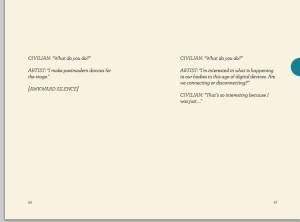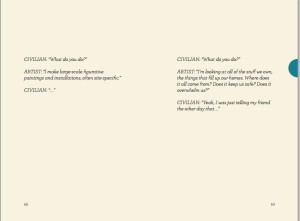Last month Springboard for the Arts tweeted that the attendance at the Guthrie Theatre’s attendance last year exceeded the Minnesota Vikings’ home game attendance, 425,932 to 421,668.
Springboard Executive Director Laura Zabel blogged about these numbers suggesting the 400k Guthrie audience members should manifest their love for the theater in the same way Vikings’ fans do–jerseys and facepaint.
One of my first thoughts, based on some of Zabel’s observations, was about whether tax dollars were better spent building a stadium which is only used 8 times a year by 400,000 people or a theatre which is used hundreds of nights a year by the same number.
But I quickly remembered the big to do about the lack of diversity in Guthrie’s current season. I wondered if the attendance numbers reflected any push back against that.
Based on a calendar year comparison, it hasn’t. At the end of 2011 their attendance was 421,982. That, however, was down from 2010 when their attendance was 435,877.
I don’t have any numbers comparing their seasons which run September – August. There could have been a precipitous drop off September – December 2012 that isn’t readily apparent. My suspicion, however, is that audiences by and large don’t care about diversity, or the lack thereof, as much as people in the arts sector do.
Diversity is an internal concern driven by economic and philosophic motivations rather than by external audience demands. Audiences do want works that speak to them so arts organizations pursue diversity in order to bolster attendance by expanding the appeal of their works.
Non-profit arts organizations are also widely motivated by their educational mission to expose their audiences to new ideas which is often manifested by who is chosen to perform and whose ideas are chosen to be presented.
While arts organizations have to be responsive to the tastes and interests of their audiences, the audiences take a pretty passive role when it comes to programming. They aren’t widely clamoring for their local arts organizations to bring in new faces and new ideas.
If they were, it would actually be easier to program a season because you would have an idea of what people wanted instead of having an empty theatre teach you what they didn’t.
The Guthrie’s artistic director, Joe Dowling noted that many of the shows in their current season were brought to him by the directors. That is how the programming decisions of most arts organizations are driven, artists and agents, rather than audiences approach decision makers with ideas.
In fact, one of the things artistic directors probably cringe most at is being approached by an audience member who says “I know this group…” I would have sworn it would never come to pass, but this season we are actually doing a show based on a usher coming up and essentially saying, “I am in this band…” It does happen, but often audience suggestions don’t reflect an understanding of the organization’s artistic and business models.
Just the same, that feedback can provide insight into the type of experience the audience member is looking for. Presenting Lady Gaga may be totally wrong for the Guthrie Theater, but a show where the audience can vicariously identify with the protagonist’s rise to celebrity might work great.
As you are all well aware, arts organizations are in the unenviable position of having to figure it all out. It is difficult to pursue any one agenda as wholeheartedly as you might wish. Program too conservatively and audiences will say the arts are arrogant and out of touch for telling them they ought to value antiquated works by Mozart and Shakespeare. Program too progressively and audiences will say the arts are arrogant for telling them they ought to value works challenging notions of gender, race and politics.
I don’t mean to champion a middle of the road approach. I could easily argue, as many people did regarding the Guthrie’s season, that I have far more diversity on my stage and in my audiences just by cultivating locally available artistic resources. I also know that may be harder to achieve in the next job I hold. A balance between leading and following has to be struck and recalibrated all the time.

